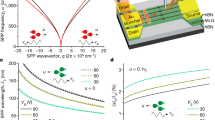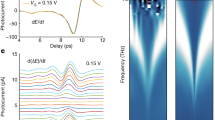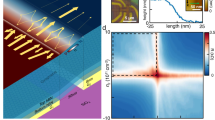Abstract
Fizeau demonstrated in 1850 that the speed of light can be modified when it is propagating in moving media1. However, such control of the light speed has not been achieved efficiently with a fast-moving electron media by passing an electrical current. Because the strong electromagnetic coupling between the electron and light leads to the collective excitation of plasmon polaritons, it is hypothesized that Fizeau drag in electron flow systems manifests as a plasmonic Doppler effect. Experimental observation of the plasmonic Doppler effect in electronic systems has been challenge because the plasmon propagation speed is much faster than the electron drift velocity in conventional noble metals. Here we report direct observation of Fizeau drag of plasmon polaritons in strongly biased monolayer graphene by exploiting the high electron mobility and the slow plasmon propagation of massless Dirac electrons. The large bias current in graphene creates a fast-drifting Dirac electron medium hosting the plasmon polariton. This results in non-reciprocal plasmon propagation, where plasmons moving with the drifting electron media propagate at an enhanced speed. We measure the Doppler-shifted plasmon wavelength using cryogenic near-field infrared nanoscopy, which directly images the plasmon polariton mode in the biased graphene at low temperature. We observe a plasmon wavelength difference of up to 3.6 per cent between a plasmon moving with and a plasmon moving against the drifting electron media. Our findings on the plasmonic Doppler effect provide opportunities for electrical control of non-reciprocal surface plasmon polaritons in non-equilibrium systems.
This is a preview of subscription content, access via your institution
Access options
Access Nature and 54 other Nature Portfolio journals
Get Nature+, our best-value online-access subscription
$29.99 / 30 days
cancel any time
Subscribe to this journal
Receive 51 print issues and online access
$199.00 per year
only $3.90 per issue
Buy this article
- Purchase on Springer Link
- Instant access to full article PDF
Prices may be subject to local taxes which are calculated during checkout




Similar content being viewed by others
Data availability
The data that support the findings of this study are available from the corresponding author upon reasonable request.
References
Foucault, L. Méthode générale pour mesurer la vitesse de la lumière dans l’air et les milieux transparents. Vitesses relatives de la lumière dans l’air et dans l’eau. Projet d’expérience sur la vitesse de propagation du calorique rayonnant. C. R. Acad. Sci. 30, 551–560 (1850).
Christensen, T. in From Classical to Quantum Plasmonics in Three and Two Dimensions 13–35 (Springer, 2017).
Maier, S. A. Plasmonics: Fundamentals and Applications (Springer Science & Business Media, 2007).
Jablan, M., Soljačić, M. & Buljan, H. Plasmons in graphene: fundamental properties and potential applications. Proc. IEEE 101, 1689–1704 (2013).
Low, T. et al. Polaritons in layered two-dimensional materials. Nat. Mater. 16, 182–194 (2017).
Novotny, L. & Hecht, B. Principles of Nano-optics (Cambridge Univ. Press, 2012).
Kauranen, M. & Zayats, A. V. Nonlinear plasmonics. Nat. Photon. 6, 737–748 (2012).
Bozhevolnyi, S. I., Martin-Moreno, L. & Garcia-Vidal, F. Quantum Plasmonics (Springer, 2017).
Yu, N. & Capasso, F. Flat optics with designer metasurfaces. Nat. Mater. 13, 139–150 (2014).
Xia, F., Wang, H., Xiao, D., Dubey, M. & Ramasubramaniam, A. Two-dimensional material nanophotonics. Nat. Photon. 8, 899–907 (2014).
Castro Neto, A. H., Guinea, F., Peres, N. M., Novoselov, K. S. & Geim, A. K. The electronic properties of graphene. Rev. Mod. Phys. 81, 109–162 (2009).
Ni, G. et al. Fundamental limits to graphene plasmonics. Nature 557, 530–533 (2018).
Koppens, F. H., Chang, D. E. & Garcia de Abajo, F. J. Graphene plasmonics: a platform for strong light–matter interactions. Nano Lett. 11, 3370–3377 (2011).
Dean, C. R. et al. Boron nitride substrates for high-quality graphene electronics. Nat. Nanotechnol. 5, 722–726 (2010).
Mak, K. F. et al. Measurement of the optical conductivity of graphene. Phys. Rev. Lett. 101, 196405 (2008).
Zhang, Y., Small, J. P., Pontius, W. V. & Kim, P. Fabrication and electric-field-dependent transport measurements of mesoscopic graphite devices. Appl. Phys. Lett. 86, 073104 (2005).
Yu, Y.-J. et al. Tuning the graphene work function by electric field effect. Nano Lett. 9, 3430–3434 (2009).
Dorgan, V. E., Bae, M.-H. & Pop, E. Mobility and saturation velocity in graphene on SiO2. Appl. Phys. Lett. 97, 082112 (2010).
Woessner, A. et al. Highly confined low-loss plasmons in graphene–boron nitride heterostructures. Nat. Mater. 14, 421–425 (2015).
Fei, Z. et al. Gate-tuning of graphene plasmons revealed by infrared nano-imaging. Nature 487, 82–85 (2012).
Chen, J. et al. Optical nano-imaging of gate-tunable graphene plasmons. Nature 487, 77–81 (2012).
Jablan, M., Buljan, H. & Soljačić, M. Plasmonics in graphene at infrared frequencies. Phys. Rev. B 80, 245435 (2009).
Ramamoorthy, H. et al. “Freeing” graphene from its substrate: observing intrinsic velocity saturation with rapid electrical pulsing. Nano Lett. 16, 399–403 (2016).
Borgnia, D. S., Phan, T. V. & Levitov, L. S. Quasi-relativistic Doppler effect and non-reciprocal plasmons in graphene. Preprint at https://arxiv.org/abs/1512.09044 (2015).
Correas-Serrano, D. & Gomez-Diaz, J. Non-reciprocal and collimated surface plasmons in drift-biased graphene metasurfaces. Phys. Rev. B 100, 081410 (2019).
Morgado, T. A. & Silveirinha, M. G. Drift-induced unidirectional graphene plasmons. ACS Photon. 5, 4253–4258 (2018).
Sabbaghi, M., Lee, H.-W. & Stauber, T. Electro-optics of current-carrying graphene. Phys. Rev. B 98, 075424 (2018).
Sabbaghi, M., Lee, H.-W., Stauber, T. & Kim, K. S. Drift-induced modifications to the dynamical polarization of graphene. Phys. Rev. B 92, 195429 (2015).
Wenger, T., Viola, G., Kinaret, J., Fogelström, M. & Tassin, P. Current-controlled light scattering and asymmetric plasmon propagation in graphene. Phys. Rev. B 97, 085419 (2018).
Van Duppen, B., Tomadin, A., Grigorenko, A. N. & Polini, M. Current-induced birefringent absorption and non-reciprocal plasmons in graphene. 2D Mater. 3, 015011 (2016).
Song, J. C. & Rudner, M. S. Chiral plasmons without magnetic field. Proc. Natl Acad. Sci. USA 113, 4658–4663 (2016).
Hamm, J. M., Page, A. F., Bravo-Abad, J., Garcia-Vidal, F. J. & Hess, O. Nonequilibrium plasmon emission drives ultrafast carrier relaxation dynamics in photoexcited graphene. Phys. Rev. B 93, 041408 (2016).
Morgado, T. A. & Silveirinha, M. G. Negative Landau damping in bilayer graphene. Phys. Rev. Lett. 119, 133901 (2017).
Ni, G. et al. Ultrafast optical switching of infrared plasmon polaritons in high-mobility graphene. Nat. Photon. 10, 244–247 (2016).
Page, A. F., Ballout, F., Hess, O. & Hamm, J. M. Nonequilibrium plasmons with gain in graphene. Phys. Rev. B 91, 075404 (2015).
Lin, X. et al. Unidirectional surface plasmons in nonreciprocal graphene. New J. Phys. 15, 113003 (2013).
Wang, Z., Chong, Y., Joannopoulos, J. D. & Soljačić, M. Reflection-free one-way edge modes in a gyromagnetic photonic crystal. Phys. Rev. Lett. 100, 013905 (2008).
Yu, Z., Veronis, G., Wang, Z. & Fan, S. One-way electromagnetic waveguide formed at the interface between a plasmonic metal under a static magnetic field and a photonic crystal. Phys. Rev. Lett. 100, 023902 (2008).
Wang, L. et al. One-dimensional electrical contact to a two-dimensional material. Science 342, 614–617 (2013).
Ocelic, N., Huber, A. & Hillenbrand, R. Pseudoheterodyne detection for background-free near-field spectroscopy. Appl. Phys. Lett. 89, 101124 (2006).
Kotov, V. N., Uchoa, B., Pereira, V. M., Guinea, F. & Neto, A. C. Electron–electron interactions in graphene: current status and perspectives. Rev. Mod. Phys. 84, 1067–1125 (2012).
Morgado, T. A. & Silveirinha, M. G. Nonlocal effects and enhanced nonreciprocity in current-driven graphene systems. Phys. Rev. B 102, 075102 (2020).
Geick, R., Perry, C. & Rupprecht, G. Normal modes in hexagonal boron nitride. Phys. Rev. 146, 543–547 (1966).
Hwang, C. et al. Fermi velocity engineering in graphene by substrate modification. Sci. Rep. 2, 590 (2012).
Dong, Y. et al. Fizeau drag in graphene plasmonics. Nature https://www.nature.com/articles/s41586-021-03640-x (2021).
Ponomarenko, L. et al. Cloning of Dirac fermions in graphene superlattices. Nature 497, 594–597 (2013).
Yankowitz, M. et al. Emergence of superlattice Dirac points in graphene on hexagonal boron nitride. Nat. Phys. 8, 382–386 (2012).
Acknowledgements
The device fabrication and characterization and theoretical analysis of the work is supported by the Director, Office of Science, Office of Basic Energy Sciences, Materials Sciences and Engineering Division of the US Department of Energy under contract number DE-AC02-05CH11231 (sp2-Bonded Materials Program KC2207). The cryogenic near-field nanoscopy measurement was supported by the NSF award 1808635. K.W. and T.T. acknowledge support from the Elemental Strategy Initiative conducted by the MEXT, Japan and the CREST (JPMJCR15F3), JST.
Author information
Authors and Affiliations
Contributions
F.W. conceived the research. W.Z. and S.Z. carried out the near-field optical measurements. W.Z., S.Z., Sheng Wang, S.Y. and F.W. performed the data analysis. W.Z., S.Z., H.L., Shaoxin Wang, M.I.B.U, S.K., Y.J. and X.X. fabricated the graphene devices. K.W. and T.T. grew the hexagonal boron nitride crystals. All authors discussed the results and wrote the manuscript.
Corresponding author
Ethics declarations
Competing interests
The authors declare no competing interests.
Additional information
Peer review information Nature thanks Jiahua Duan, Joel Cox and Hugen Yan for their contribution to the peer review of this work.
Publisher’s note Springer Nature remains neutral with regard to jurisdictional claims in published maps and institutional affiliations.
Extended data figures and tables
Extended Data Fig. 1 Graphene channel current at discrete bias voltages in the two-terminal device.
Measurements taken at 25 K at a carrier density of 7.0 × 1012 cm−2.
Extended Data Fig. 2 Near-field signal of the propagating plasmon on the left side of the gold nanobar.
a, b, Illustration of plasmon propagation under negative (a) and positive (b) current flows. c, e, g, Near-field data at −0.4 mA and + 0.4 mA (c), −1.2 mA and + 1.2 mA (e) and −1.9 mA and +1.7 mA (g). d, f, h, The corresponding line profiles for c, e, g, respectively, averaged over the 30 scans. The gold nanobar is located on the right and the graphene plasmons propagate from the right to the left.
Extended Data Fig. 3 Near-field signal of the propagating plasmon on the right side of the gold nanobar.
a, b, Illustration of plasmon propagation under negative (a) and positive (b) current flows. c, e, Near-field data at −0.4 mA and +0.4 mA (c) and −1.2 mA and +1.2 mA (e). d, f, The corresponding line profiles c, e, respectively, averaged over the 30 scans. The gold nanobar is located on the left and the graphene plasmons propagate from the left to the right.
Extended Data Fig. 4 Comparison of the Doppler effect between theory and experiment at different carrier drift velocities in the second device.
The width of the graphene channel is w = 2.5 μm and the carrier density is estimated to be |n| = 7.0 × 1012 cm−2.
Extended Data Fig. 5 Breakdown of device under high positive backgate voltages.
The ultrahigh backgate voltage at the positive side triggers a series of gas ionization in high vacuum and damages the sample.
Extended Data Fig. 6 Filtered optical image to enhance the contrast between hBN and graphene.
The alignment angle between the hBN and graphene is around 0.93° and corresponds to a moiré period of around 10.3 nm, which is calculated from the carrier density (ns ≈ 3.98 × 1012 cm−2) at the small resistance peak in our device.The white line indicates the straight graphene edge and the yellow line shows the top hBN edge.
Rights and permissions
About this article
Cite this article
Zhao, W., Zhao, S., Li, H. et al. Efficient Fizeau drag from Dirac electrons in monolayer graphene. Nature 594, 517–521 (2021). https://doi.org/10.1038/s41586-021-03574-4
Received:
Accepted:
Published:
Issue Date:
DOI: https://doi.org/10.1038/s41586-021-03574-4
This article is cited by
-
High anisotropy in electrical and thermal conductivity through the design of aerogel-like superlattice (NaOH)0.5NbSe2
Nature Communications (2023)
-
Doping-driven topological polaritons in graphene/α-MoO3 heterostructures
Nature Nanotechnology (2022)
-
Plasmonic gain in current biased tilted Dirac nodes
Nature Communications (2022)
-
Manipulating polaritons at the extreme scale in van der Waals materials
Nature Reviews Physics (2022)
Comments
By submitting a comment you agree to abide by our Terms and Community Guidelines. If you find something abusive or that does not comply with our terms or guidelines please flag it as inappropriate.



